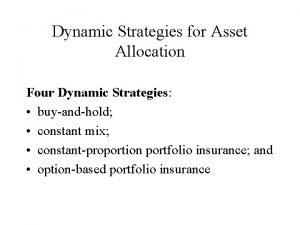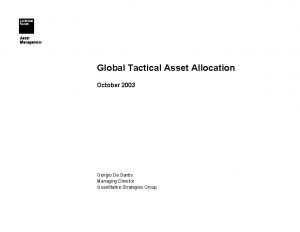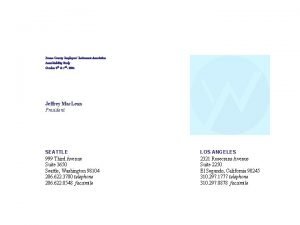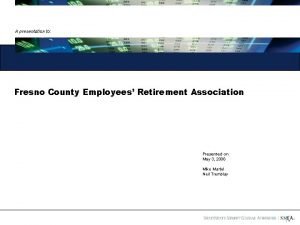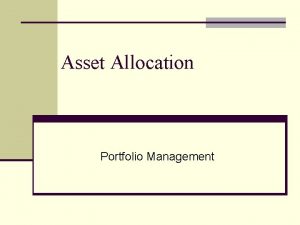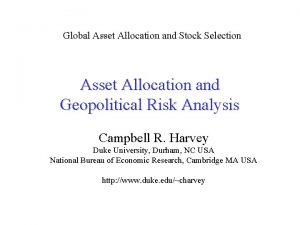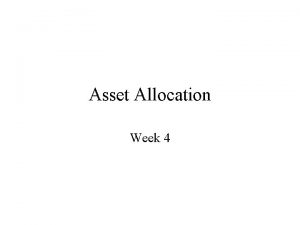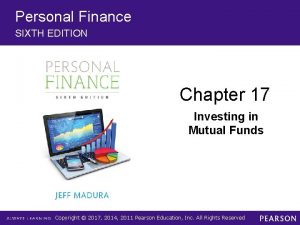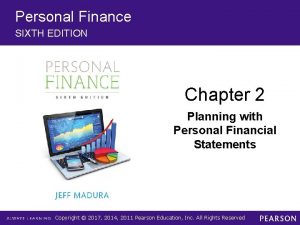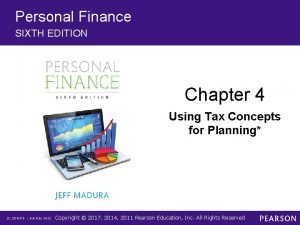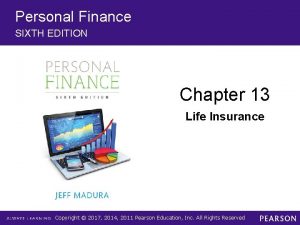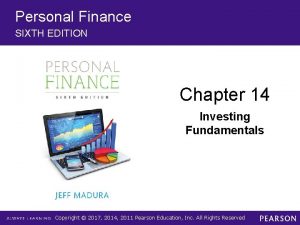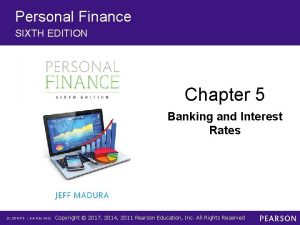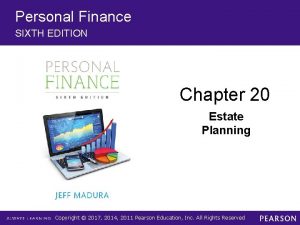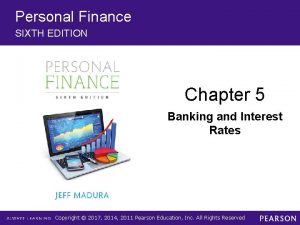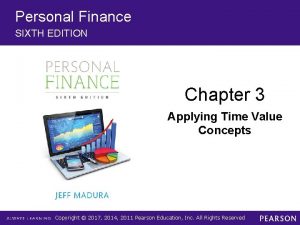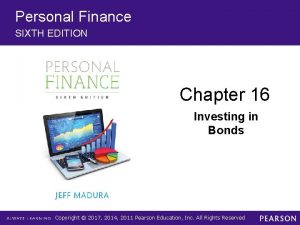Personal Finance SIXTH EDITION Chapter 18 Asset Allocation





























- Slides: 29

Personal Finance SIXTH EDITION Chapter 18 Asset Allocation Copyright © 2017, 2014, 2011 Pearson Education, Inc. All Rights Reserved

Chapter Objectives 18. 1 Explain how diversification among assets can reduce risk 18. 2 Describe strategies that can be used to diversify among stocks 18. 3 Explain asset allocation strategies 18. 4 Identify factors that affect your asset allocation decisions 18. 5 Explain how asset allocation fits within your financial plan Copyright © 2017, 2014, 2011 Pearson Education, Inc. All Rights Reserved

How Diversification Reduces Risk (1 of 6) • Benefits of portfolio diversification – Asset allocation: the process of allocating money across financial assets with the objective of achieving a desired return while maintaining risk of a tolerable level – Building a portfolio § Portfolio: a set of multiple investments in different Copyright © 2017, 2014, 2011 Pearson Education, Inc. All Rights Reserved

How Diversification Reduces Risk (2 of 6) • Determining portfolio benefits – Compare return on the investments within the portfolio to the overall portfolio – Diversification reduces the exposure of your investments to the adverse effects of any individual investment Copyright © 2017, 2014, 2011 Pearson Education, Inc. All Rights Reserved

How Diversification Reduces Risk (3 of 6) Copyright © 2017, 2014, 2011 Pearson Education, Inc. All Rights Reserved

How Diversification Reduces Risk (4 of 6) • Factors that influence diversification benefits – Volatility of each individual investment – Impact of correlations among investments § Highly correlated stocks limit diversification § Consider stocks that are not influenced by the same conditions Copyright © 2017, 2014, 2011 Pearson Education, Inc. All Rights Reserved

How Diversification Reduces Risk (5 of 6) Copyright © 2017, 2014, 2011 Pearson Education, Inc. All Rights Reserved

How Diversification Reduces Risk (6 of 6) Copyright © 2017, 2014, 2011 Pearson Education, Inc. All Rights Reserved

Financial Planning Online (1 of 2) • Go to the finance section of Yahoo. com • Click “Get Quotes” after inserting a stock ticker symbol. • This Web site will give you a trend of the stock price. Notice that you can customize the trend to focus on the period in which you are interested Copyright © 2017, 2014, 2011 Pearson Education, Inc. All Rights Reserved

Strategies for Diversifying (1 of 3) • Diversification of stocks across industries – Less risky than a portfolio of stocks all from the same industry – Limitations of industry diversification § Even such a portfolio is still susceptible to general economic conditions § Cannot prevent losses but may limit them Copyright © 2017, 2014, 2011 Pearson Education, Inc. All Rights Reserved

Strategies for Diversifying (2 of 3) • Diversification of stocks across countries – Economic conditions tend to vary among countries – Foreign stocks typically more volatile than U. S. stocks so it is best to diversify among stocks within each foreign country – Many advisors recommend an 80/20 split between U. S. and foreign stocks Copyright © 2017, 2014, 2011 Pearson Education, Inc. All Rights Reserved

Strategies for Diversifying (3 of 3) • Economic impact on global diversification benefits – International diversification does not completely insulate investors from a weak economy – During 2008 -2009, even non U. S. stock markets performed poorly Copyright © 2017, 2014, 2011 Pearson Education, Inc. All Rights Reserved

Asset Allocation Strategies (1 of 8) • Including bonds in the portfolio – Bond and stock returns are not highly correlated – Investing in more bonds lowers market risk but increases interest rate risk • Including real estate investments in the portfolio – Real estate investment trusts (REITs): trusts that pool investments from individuals and use the proceeds to invest in real estate Copyright © 2017, 2014, 2011 Pearson Education, Inc. All Rights Reserved

Asset Allocation Strategies (2 of 8) – Similar to closed-end mutual funds – Managed by real estate professional – Types of REITs § Equity REITs: REITs that invest money directly in properties § Mortgage REITs: REITs that invest in mortgage loans that help to finance the development of properties Copyright © 2017, 2014, 2011 Pearson Education, Inc. All Rights Reserved

Asset Allocation Strategies (3 of 8) – Role of REITs in asset allocation § Highly influenced by real estate conditions § Exposes investors to high risk § Investors in REITs may want to further diversify their portfolios Copyright © 2017, 2014, 2011 Pearson Education, Inc. All Rights Reserved

Asset Allocation Strategies (4 of 8) • Including stock options in the portfolio – Stock option: an option to purchase or sell stocks under specified conditions – Traded on exchanges – Call option: provides the right to purchase 100 shares of a specified stock at a specified price by a specified expiration date Copyright © 2017, 2014, 2011 Pearson Education, Inc. All Rights Reserved

Asset Allocation Strategies (5 of 8) – Exercise (strike) price: the price at which a stock option is exercised – Premium: the price that you pay when purchasing a stock option – Put option: provides the right to sell 100 shares of a specified stock at a specified price by a specified date Copyright © 2017, 2014, 2011 Pearson Education, Inc. All Rights Reserved

Asset Allocation Strategies (6 of 8) • The role of stock options in asset allocation – Very risky; should only play a minimal role in asset allocation – Covered call strategy: selling call options on stock that you own • How asset allocation affects risk – To maintain a low risk, asset allocation should emphasize low risk investments Copyright © 2017, 2014, 2011 Pearson Education, Inc. All Rights Reserved

Asset Allocation Strategies (7 of 8) – In 2008, stocks, real estate and low-rated corporate bonds experienced losses – This type of asset allocation strategy would have resulted in a large loss • An affordable way to conduct asset allocation – Invest in different types of mutual funds Copyright © 2017, 2014, 2011 Pearson Education, Inc. All Rights Reserved

Asset Allocation Strategies (8 of 8) Copyright © 2017, 2014, 2011 Pearson Education, Inc. All Rights Reserved

Your Asset Allocation Decision • Your stage in life – Younger investors need safer, more liquid securities – In the middle stage, investors may reduce risky assets and hold more safe assets – Investors nearing retirement may reduce risky assets even further and allocate more funds toward Treasury bonds Copyright © 2017, 2014, 2011 Pearson Education, Inc. All Rights Reserved

Factors That Affect the Asset Allocation Decision (1 of 3) • Your degree of risk tolerance • Your expectations about economic conditions – If you expect a strong stock market, invest in stocks – If you expect a weak stock market, invest in bonds – If you expect lower interest rates, invest in long-term bonds – If you expect favorable real estate conditions, invest in REITs Copyright © 2017, 2014, 2011 Pearson Education, Inc. All Rights Reserved

Factors That Affect the Asset Allocation Decision (2 of 3) Copyright © 2017, 2014, 2011 Pearson Education, Inc. All Rights Reserved

Factors That Affect the Asset Allocation Decision (3 of 3) Copyright © 2017, 2014, 2011 Pearson Education, Inc. All Rights Reserved

Financial Planning Online (2 of 2) • Go to the personal investor section of http: //www. vanguard. com • This Web site provides a personalized recommended asset allocation once you input some basic information about your preferences and degree of risk tolerance. Copyright © 2017, 2014, 2011 Pearson Education, Inc. All Rights Reserved

How Asset Allocation Fits Within Your Financial Plan (1 of 4) • Key decision concerning asset allocation for your financial plan are: – Is your present asset allocation of investments appropriate? – How will you apply asset allocation in the future? Copyright © 2017, 2014, 2011 Pearson Education, Inc. All Rights Reserved

How Asset Allocation Fits Within Your Financial Plan (2 of 4) EXHIBIT 18. 7 How Asset Allocation Fits Within Stephanie Spratt’s Financial Plan GOALS FOR ASSET ALLOCATION 1. Ensure that my present asset allocation is appropriate. 2. Determine a plan for asset allocation in the future as I accumulate more money. ANALYSIS Market Value of Investment Proportion of Invested Funds Allocated to This Investment $3, 000/$5, 000 = 60% Stock mutual fund 1, 000 $1, 000/$5, 000 = 20% Bond mutual fund 1, 000 $1, 000/$5, 000 = 20% Investment Common stock Total $5, 000 Copyright © 2017, 2014, 2011 Pearson Education, Inc. All Rights Reserved

How Asset Allocation Fits Within Your Financial Plan (3 of 4) EXHIBIT 18. 7 How Asset Allocation Fits Within Stephanie Spratt’s Financial Plan DECISIONS Decision on Whether My Present Asset Allocation Is Appropriate: My present asset allocation is too heavily concentrated on one stock. With just $5, 000 in investments, I should probably have all of my money invested in mutual funds so that my investments are more diversified. I should consider selling the stock and investing the proceeds in a stock mutual fund. I already own shares of a mutual fund focused on technology firms. I will invest the proceeds from selling my stock in a different type of stock mutual fund so that I can achieve more diversification. Copyright © 2017, 2014, 2011 Pearson Education, Inc. All Rights Reserved

How Asset Allocation Fits Within Your Financial Plan (4 of 4) EXHIBIT 18. 7 How Asset Allocation Fits Within Stephanie Spratt’s Financial Plan Decision on Asset Allocation in the Future: Once I revise my asset allocation as described above, I will have $4, 000 invested in stock mutual funds and $1, 000 in bond mutual funds. This revision will result in a balance of 80% invested in stock funds and 20% invested in bond funds. The stock funds have a higher potential return than the bond funds. During the next few years, I will invest any extra money I have in stock or bond mutual funds, maintaining the same 80/20 ratio. Copyright © 2017, 2014, 2011 Pearson Education, Inc. All Rights Reserved
 Peter pickle tongue twister
Peter pickle tongue twister Rubber baby buggy bumpers tongue twister lyrics
Rubber baby buggy bumpers tongue twister lyrics Personal finance 6th edition
Personal finance 6th edition Linked allocation
Linked allocation Flexible asset allocation
Flexible asset allocation Dynamic strategies for asset allocation
Dynamic strategies for asset allocation Gtaa global tactical asset allocation
Gtaa global tactical asset allocation Capital allocation between risky and risk-free assets
Capital allocation between risky and risk-free assets Asset allocation process
Asset allocation process Fresno asset allocation
Fresno asset allocation Fresno county employees retirement association
Fresno county employees retirement association Biochemistry sixth edition 2007 w.h. freeman and company
Biochemistry sixth edition 2007 w.h. freeman and company Computer architecture a quantitative approach sixth edition
Computer architecture a quantitative approach sixth edition Automotive technology sixth edition
Automotive technology sixth edition Automotive technology sixth edition
Automotive technology sixth edition Apa sixth edition
Apa sixth edition Computer architecture a quantitative approach sixth edition
Computer architecture a quantitative approach sixth edition Precalculus sixth edition
Precalculus sixth edition Principles of economics sixth edition
Principles of economics sixth edition Computer architecture a quantitative approach sixth edition
Computer architecture a quantitative approach sixth edition Risk allocation in project finance
Risk allocation in project finance Chapter 2 personal finance
Chapter 2 personal finance Chapter 1 introduction to personal finance answer key
Chapter 1 introduction to personal finance answer key Chapter 8 personal finance
Chapter 8 personal finance Chapter 4 review personal finance
Chapter 4 review personal finance Personal finance chapter 1
Personal finance chapter 1 Overview of personal finance chapter 1
Overview of personal finance chapter 1 Fundamentals of corporate finance 3rd canadian edition
Fundamentals of corporate finance 3rd canadian edition Corporate finance tenth edition
Corporate finance tenth edition Fundamentals of corporate finance canadian edition
Fundamentals of corporate finance canadian edition





